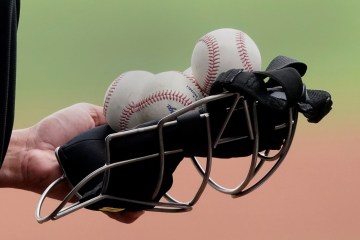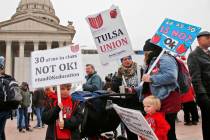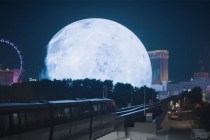Desert born and bred: residents talk about Las Vegas’ past
View Neighborhood Newspapers interviewed many longtime Las Vegas-area residents about their memories of the valley and how it has changed over the years. The following are from members of the Spring Valley and southwest-area community.
A safer place and time
Imagine a Las Vegas with little threat of crime. Spring Valley resident Sharon Friend remembers when that was reality.
"We didn't have doors that locked," said Friend, whose parents owned a motel on Fifth Street downtown. "Even at the motel, nobody was afraid. I would run free and barefooted, literally."
Friend's ties to the valley date to May 15, 1905, the day Las Vegas became a city. More than 100 acres in the area of present-day downtown were auctioned off, and Friend's grandfather, Illinois native Jake Beckley, bought land on First Street. Beckley and childhood friend Ed Von Tobel opened a lumber yard together. Beckley later opened a clothing store with his brother, Will Beckley.
Friend was born in 1942, two years after her grandfather died. And although she never met him, she learned about him from her grandmother, who raised Friend for part of her childhood.
Around the time of her grandfather's arrival, Las Vegas was being advertised as "a suburb of Goodsprings," Friend said. Goodsprings, about 30 miles southwest of Las Vegas, had a population of 229 in 2010.
Las Vegas puttered along slowly until the Hoover Dam project began in 1931. Friend's mother, Eunice Beckley, was featured water skiing on the cover of the brochure passed out at the dam's opening. Friend still has the brochure.
Beckley and her husband, David Boles, built a house in the neighborhood near Rancho Drive and Charleston Boulevard still known as The Scotch 80's. Las Vegas' first mayor, Peter Buol, helped secure funding for the 80-acre development by traveling to Scotland to make a pitch to investors, giving the neighborhood a nickname that stuck.
Friend's home was "like living on a farm," she said. Her family raised "every kind of possible animal" at home. Pigeons, she said, have the ugliest babies.
Friend has been in Las Vegas almost exclusively ever since. She attended West Charleston Elementary School, the site of present-day Wasden Elementary School, 2831 Palomino Lane. She graduated in 1960 from Las Vegas High School, which opened in 1931 as the valley's first high school and was on the site of present-day Las Vegas Academy, 315 S. Seventh St.
Cruising up and down Fremont Street was a popular activity among students, Friend said. Kids would meet at the Blue Onion drive-in near Fremont Street and Boulder Highway and circle back around for another loop.
Friend attended the University of Arizona and married three days after graduation. She moved to Michigan but could not get used to the frigid winter weather and returned home the same year.
Her fondest memories growing up include spending summers at Lake Mead, winters at Mount Charleston and going to the Thunderbird on the Strip, which later became the El Rancho, to visit its vast candy shop and buy rock candy.
Friend has since raised three children of her own and has six grandkids. The biggest change she has noticed is "the lack of people that you know that care about your kids."
"I was so taken care of by everyone in the city," she said. "Raising my kids here, they weren't allowed to run as free as I was.
"No matter where we went as kids, someone knew who we were. And believe me, our parents knew before we got home if we did something wrong."
'It was all dirt roads'
Spring Valley resident Marilyn Thornell grew up a few years after Friend but remembers a similar air of security as a kid.
"Things changed in a negative way," Thornell said. "Now there is crime ... It was so much fun growing up because we didn't have all this stuff. (After school) you went outside, and we didn't come home until it was dark. You didn't worry about anything; you didn't have to lock your doors."
Thornell was born in 1950 and was part of Clark High School's inaugural sophomore class before graduating in 1968. She recalled the luxury that was a black-and-white TV and the simplicity of daily life.
"Back then, moms didn't work," she said. "You had one car and one telephone. The dad took the car to work."
Like Friend, Thornell attended West Charleston Elementary School and, like Friend, she remembers the fun that was cruising Fremont Street and circling the Blue Onion. She also worked at the Fremont Theater, which was one of only four theaters in the valley at the time, she said.
Thornell's grandfather, Howard Conklin, moved to Las Vegas from West Virginia shortly after the land auction and owned the city's first Ford dealership, she said.
Thornell married and bought a house in 1972 near South Rainbow Boulevard and West Flamingo Road.
"Nothing was up here," she said. "It was all dirt roads back then. ... Our homes were the first up here."
The first business to sprout up in the area was a 7-Eleven, which still operates at 6885 W. Flamingo Road. She and her husband's favorite restaurant, Macayo's Mexican Kitchen, 1741 E. Charleston Blvd., also has stayed open through the years, though they dine at the West Sahara Avenue location more often nowadays.
'Liberace was a sweetheart'
Southwest-area resident Dhyani Boyar was not born in Las Vegas but moved here in 1971 from upstate New York to be a nanny to her nephew. Boyar attended the University of Nevada, Las Vegas at a time when "UNLV was one building."
Without a car, Boyar relied on the help of strangers getting to school from her home near Tropicana Avenue and Boulder Highway.
"There was nothing out there; there was nothing anywhere," she said. "I used to hitchhike all over the place, and it was very safe. A lot of kids hitchhiked to UNLV."
Boyar met her husband, Paul Boyar, on a blind date at The Brewery, a nightclub that used to be located near Paradise Road and East Desert Inn Road. Boyar would often go dancing at the club after work.
"I loved The Brewery," Boyar said. "All the people from the shows and clubs, we all used to go out until 4 or 5 a.m."
Boyar worked as a cocktail waitress at the Palomino Club in North Las Vegas for about 10 years and served many local celebrities, she said.
"Liberace was a sweetheart," she said. "He was very nice, very friendly, as opposed to some others."
Boyar declined to name some of the "others."
Boyar also worked at the Stardust as a shill at the baccarat tables.
"They would get pretty girls to play to attract customers," she said.
After marriage, Boyar became a schoolteacher and had a son, Jonathan. She is in her first year of retirement from Mackey Elementary School, 2726 Englestad St.
She talked fondly about the old casinos, most of which were demolished and replaced.
"It's not as intimate," Boyar said of today's casino culture. "Before, you knew everybody. It was more intimate and personal. Now, it's more corporations. It's about quantity and not quality."
'Vegas is in my blood'
At 33, southwest-area resident Dave Perez has the youngest memories of those interviewed. But even he remembers a much different Las Vegas during his childhood, one that was not nearly as developed.
"A lot of (Las Vegas) was just desert before," he said. "Before, we ran wild and chased lizards; we would shoot BB guns in the desert; everyone would get a season pass and spend the summer at Wet 'n Wild."
One of his favorite annual events as a kid was attending the Greek Food Festival, which was held at the Sahara but has moved to St. John the Baptist Greek Orthodox Church, 5300 El Camino Road.
Perez graduated from Bonanza High School and, at 21, started dealing blackjack at the Barbary Coast, present-day Bill's Gamblin' Hall & Saloon. He currently deals at the Wynn. His family moved to Las Vegas in the 1950s, and most of his relatives have worked in the hospitality industry.
"We've got pretty deep ties to the city," Perez said. "... I actually love this city with all of my heart. I say Vegas is in my blood."
Contact View education reporter Jeff Mosier at jmosier@viewnews.com or 702-224-5524.


















